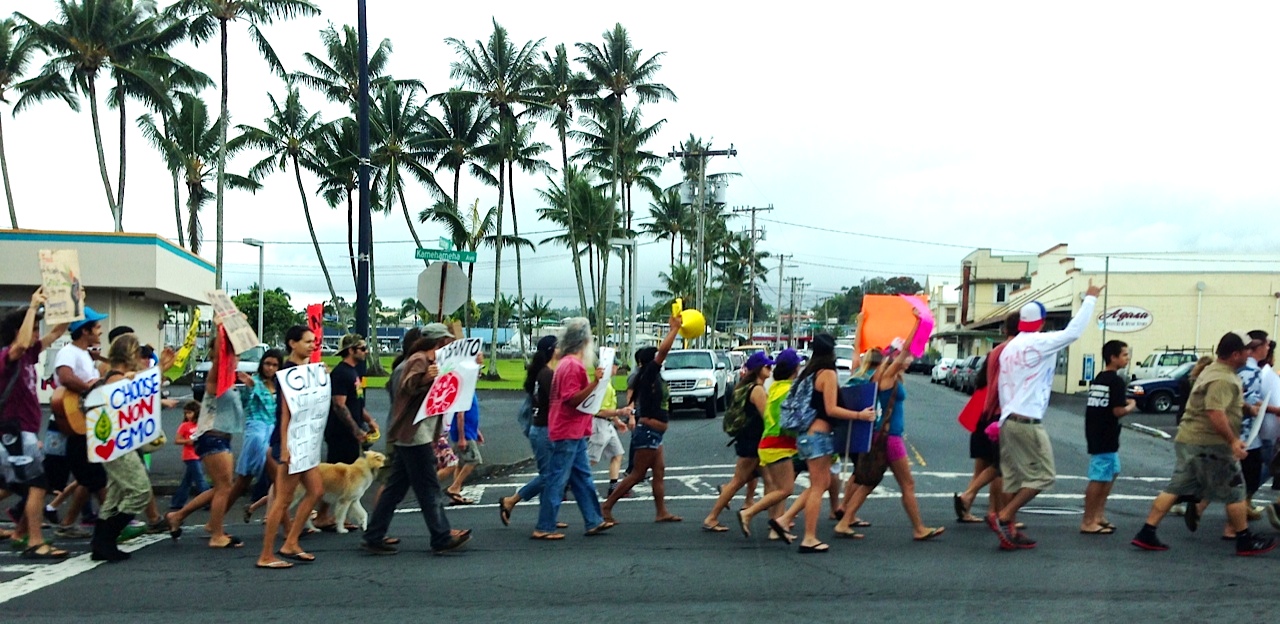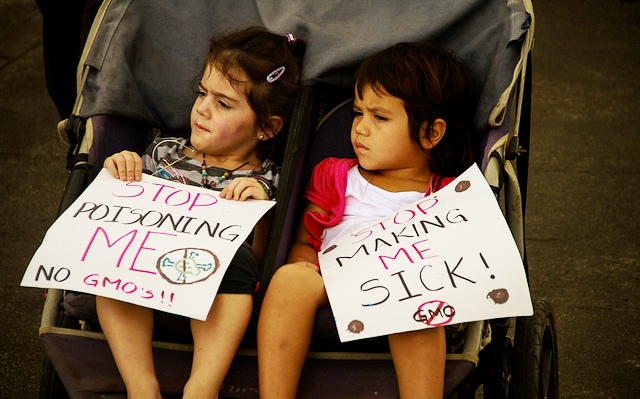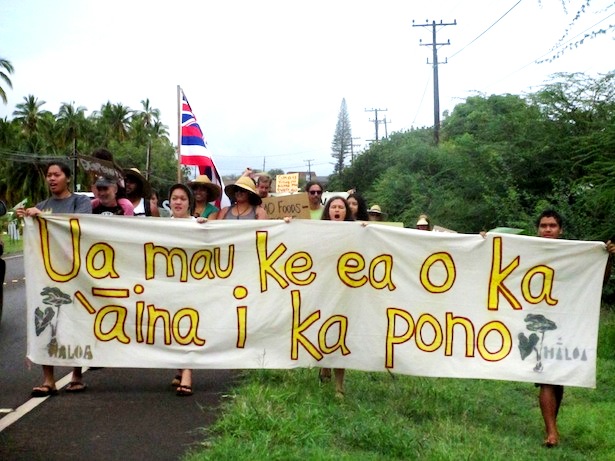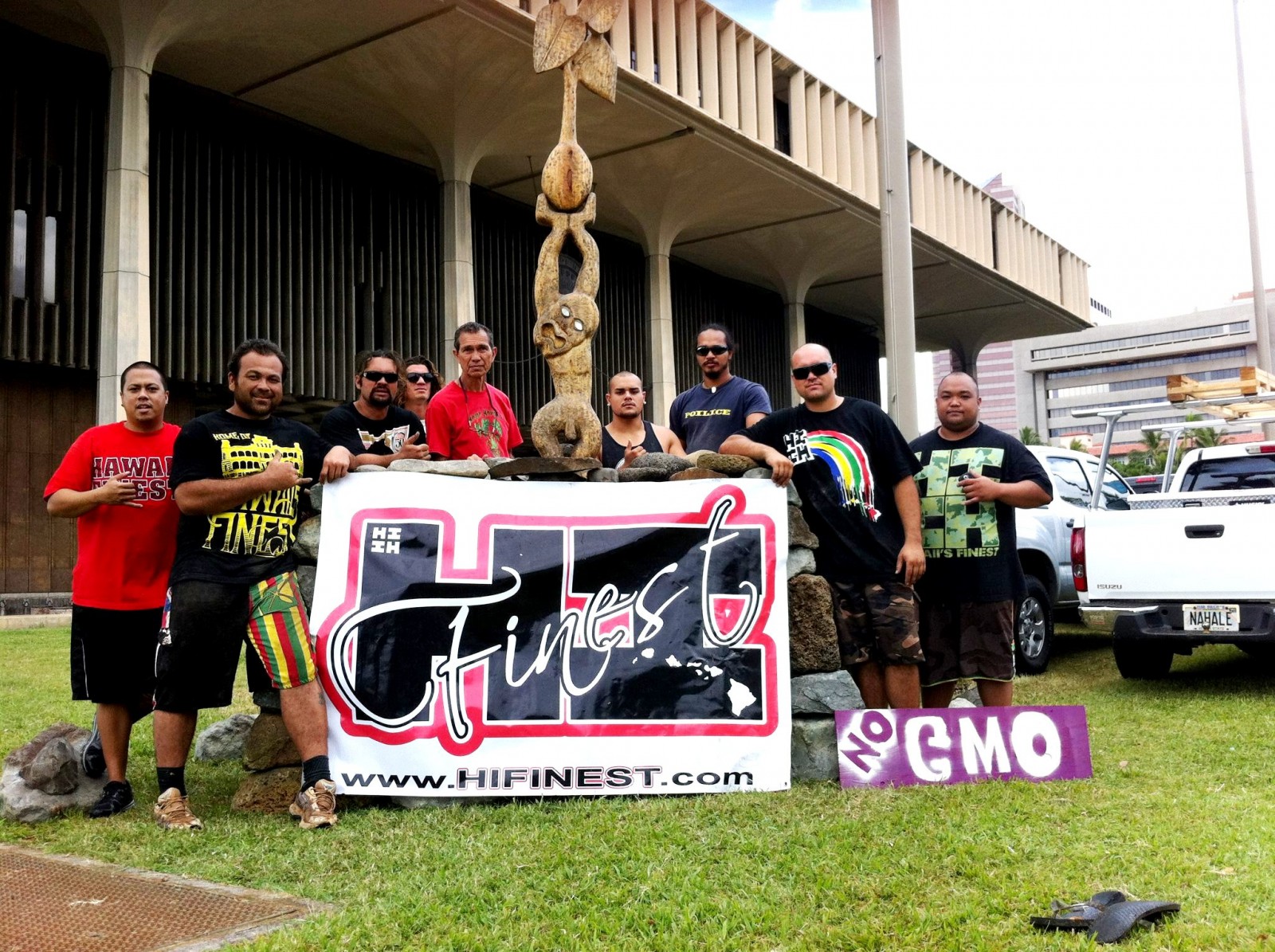At 9 am on an overcast morning in paradise, hundreds of protesters gathered in traditional Hawaiian chant and prayer. Upon hearing the sound of the conch shell, known here as Pū, the protesters followed a group of women towards Monsanto’s grounds.
“A’ole GMO,” cried the mothers as they marched alongside Monsanto’s cornfields, located only feet from their homes on Molokai, one of the smallest of Hawaii’s main islands. In a tiny, tropical corner of the Pacific that has warded off tourism and development, Monsanto’s fields are one of only a few corporate entities that separates the bare terrain of the mountains and oceans.
This spirited march was the last of a series of protests on the five Hawaiian islands that Monsanto and other biotech companies have turned into the world’s ground zero for chemical testing and food engineering. Hawaii is currently at the epicenter of the debate over genetically modified organisms, generally shortened to GMOs. Because Hawaii is geographically isolated from the broader public, it is an ideal location for conducting chemical experiments.
The island chain’s climate and abundant natural resources have lured five of the world’s largest biotech chemical corporations: Monsanto, Syngenta, Dow AgroSciences, DuPont Pioneer and BASF. In the past 20 years, these chemical companies have performed over 5,000 open-field-test experiments of pesticide-resistant crops on an estimated 40,000 to 60,000 acres of Hawaiian land without any disclosure, making the place and its people a guinea pig for biotech engineering.
The presence of these corporations has propelled one of the largest movement mobilizations in Hawaii in decades. Similar to the environmental and land sovereignty protests in Canada and the continental United States, the movement is influenced by indigenous culture.
“All of the resources that our kupuna [elders] gave to us, we need to take care of now for the next generation,” said Walter Ritte, a Hawaii activist, speaking in part in the Hawaiian indigenous language.
“That is our kuleana [responsibility]. That is everybody’s kuleana.”
In Hawaiian indigenous culture, the very idea of GMOs is effectively sacrilegious.
“For Hawaii’s indigenous peoples, the concepts underlying genetic manipulation of life forms are offensive and contrary to the cultural values of aloha ‘ʻāina [love for the land],” wrote Mililani B. Strask, a native Hawaiian attorney.
Deadly practices
Monsanto has a long history of making chemicals that bring about devastation. The company participated in the Manhattan Project to help produce the atomic bomb during World War II. It developed the herbicide “Agent Orange” used by U.S. military forces during the Vietnam War, which caused an estimated half-million birth deformities. Most recently, Monsanto has driven thousands of farmers in India to take their own lives, often by drinking chemical insecticide, after the high cost of the company’s seeds forced them into unpayable debt.
The impacts of chemical testing and GMOs are immediate — and, in the long-term, could prove deadly. In Hawaii, Monsanto and other biotech corporations have sprayed over 70 different chemicals during field tests of genetically engineered crops, more chemical testing than in any other place in the world. Human studies have not been conducted on GMO foods, but animal experiments show that genetically modified foods lead to pre-cancerous cell growth, infertility, and severe damage to the kidneys, liver and large intestines.
Additionally, the health risks of chemical herbicides sprayed onto GMO crops cause hormone disruption, cancer, neurological disorders and birth defects. In Hawaii, some open-field testing sites are near homes and schools. Prematurity, adult on-set diabetes and cancer rates have significantly increased in Hawaii in the last ten years. Many residents fear chemical drift is poisoning them.
Monsanto’s agricultural procedures also enable the practice of monocropping, which contributes to environmental degradation, especially on an island like Hawaii. Monocropping is an agricultural practice where one crop is repeatedly planted in the same spot, a system that strips the soil of its nutrients and drives farmers to use a herbicide called Roundup, which is linked to infertility. Farmers are also forced to use pesticides and fertilizers that cause climate change and reef damage, and that decrease the biodiversity of Hawaii.
Food sovereignty as resistance
At the first of the series of marches against GMOs, organizers planted coconut trees in Haleiwa, a community on the north shore of Oahu Island. In the movement, protesting and acting as caretakers of the land are no longer viewed as separate actions, particularly in a region where Monsanto is leasing more than 1,000 acres of prime agricultural soil.
During the march, people chanted and held signs declaring, “Aloha ‘āina: De-occupy Hawaii.”
The phrase aloha ‘āina is regularly seen and heard at anti-GMO protests. Today the words are defined as “love of the land,” but the phrase has also signified “love for the country.” Historically, it was commonly used by individuals and groups fighting for the restoration of the independent Hawaiian nation, and it is now frequently deployed at anti-GMO protests when people speak of Hawaiian sovereignty and independence.
After the protest, marchers gathered in Haleiwa Beach Park, where they performed speeches, music, spoken-word poetry and dance while sharing free locally grown food. The strategy of connecting with the land was also a feature of the subsequent protest on the Big Island, where people planted taro before the march, and also at the state capitol rally, where hundreds participated in the traditional process of pounding taro to make poi, a Polynesian staple food.
The import economy is a new reality for Hawaii, one directly tied to the imposition of modern food practices on the island. Ancient Hawaii operated within the Ahupua’a system, a communal model of distributing land and work, which allowed the islands to be entirely self-sufficient.
“Private land ownership was unknown, and public, common use of the ahupua’a resources demanded that boundaries be drawn to include sufficient land for residence and cultivation, freshwater sources, shoreline and open ocean access,” explained Carol Silva, an historian and Hawaiian language professor.
Inspired by the Ahupua’a model, the food sovereignty movement is building an organic local system that fosters the connections between communities and their food — a way of resisting GMOs while simultaneously creating alternatives.
Colonial history
The decline of the Ahupua’a system didn’t only set Hawaii on the path away from food sovereignty; it also destroyed the political independence of the now-U.S. state. And indeed, when protesters chant “aloha ‘āina” at anti-GMO marches, they are alluding to the fact that this fight isn’t only over competing visions of land use and food creation. It’s also a battle for the islands’ political sovereignty.
Historically, foreign corporate interests have repeatedly taken control of Hawaii — and have exploited and mistreated the land and its people in the process.
“It’s a systemic problem and the GMO issue just happens to be at the forefront of public debate at the moment,” said Keoni Lee of ʻŌiwi TV. “ʻĀina [land] equals that which provides. Provides for who?”
The presence of Monsanto and the other chemical corporations is eerily reminiscent of the business interests that led to the overthrow of the Hawaiian Kingdom. Throughout the 19th century, the Hawaiian Kingdom was recognized as an independent nation. That reality changed in 1893, when a group of American businessmen and sugar planters orchestrated a U.S. Marine’s armed coup d’etat of the Hawaiian Kingdom government.
Five years later, the U.S. apprehended the islands for strategic military use during the Spanish-American War despite local resistance. Even then-President Grover Cleveland called the overthrow a “substantial wrong” and vowed to restore the Hawaiian kingdom. But the economic interests overpowered the political will, and Hawaii remained a U.S. colony for the following 60 years.
The annexation of Hawaii profited five sugarcane-manufacturing companies commonly referred to as the Big Five: Alexander & Baldwin, Amfac (American Factors), Castle & Cooke, C. Brewer, and Theo H. Davies. Most of the founders of these companies were missionaries who were actively involved in lobbying for the annexation of the Hawaiian islands in 1898.
After the takeover, the Big Five manipulated great political power and influence in what was then considered the “Territory of Hawaii,” gaining unparalleled control of banking, shipping and importing on the island chain. The companies only sponsored white republicans in government, creating an oligarchy that threatened the labor force if it voted against their interests. The companies’ environmental practices, meanwhile, caused air and water pollution and altered the biodiversity of the land.
The current presence of the five-biotech chemical corporations in Hawaii mirrors the political and economic colonialism of the Big Five in the early 20th century — particularly because Monsanto has become the largest employer on Molokai.
“There is no difference between the “Big Five” that actually ruled Hawaii in the past,” said Walter Ritte. “Now it’s another “Big Five,” and they’re all chemical companies. So it’s almost like this is the same thing. It’s like déjàvu.”
Rising up
At the opening of this year’s legislative session on January 16, hundreds of farmers, students and residents marched to the state capitol for a rally titled “Idle No More: We the People.” There, agricultural specialist and food sovereignty activist Vandana Shiva, who traveled from India to Hawaii for the event, addressed the crowd.
“I see Hawaii not as a place where I come and people say, ‘Monsanto is the biggest employer,’ but people say, ‘this land, its biodiversity, our cultural heritage is our biggest employer,’” she said.
As she alluded to, a major obstacle facing the anti-GMO movement is the perception that the chemical corporations provide jobs that otherwise might not exist — an economic specter that the sugarcane companies also wielded to their advantage. Anti-GMO organizers are aware of how entrenched this power is.
“The things that we’re standing up against are really at the core of capitalism,” proclaimed Hawaiian rights activist Andre Perez at the rally.
Given the enormity of the enemy, anti-GMO activists are attacking the issue from a variety of fronts, including organizing mass education, advocating for non-GMO food sovereignty and pushing for legislative protections. Organizers see education, in particular, as the critical element to win this battle.
“Hawaii has the cheapest form of democracy,” said Daniel Anthony, a young local activist and founder of a traditional poi business. “Here we can educate a million people, and Monsanto is out.”
Others are using art to educate the public, such as Hawaiian rapper Hood Prince, who rails against Monsanto in his song “Say No to GMO.” This movement is also educating the community through teach-ins and the free distribution of the newly released book Facing Hawaii’s Future: Essential Information about GMOs.
Hawaii has already succeeded in protecting its traditional food from genetic engineering. Similar to the way the Big Five controlled varying sectors of society, the biotech engineering companies are financially linked to the local government, schools and university.
Monsanto partially funds the College of Tropical Agriculture and Human Resources at the University of Hawaii. The university and the Hawaii Agriculture Research Center began the process of genetically engineering taro in 2003 after the university patented three of its varieties. Once this information became widely known, it incited uproar of objection from the Hawaiian community. Taro holds spiritual significance in the islands’ indigenous culture, in which it is honored as the first Hawaiian ancestor in the creation story.
“It felt like we were being violated by the scientific community,” wrote Ritte in Facing Hawaii’s Future. “For the Hawaiian community, taro is not just a plant. It’s a family member. It’s our common ancestor ‘Haloa ... They weren’t satisfied with just taking our land; now they wanted to take our mana, our spirit too.”
The public outcry eventually drove the university to drop its patents.
Anti-GMO activists are hoping for further successes in stopping genetic food engineering. In the current legislative session, there are about a dozen proposed bills pushing GMO regulation, labeling and a ban on all imported GMO produce. These fights over mandating GMO labeling and regulation in Hawaii may seem like a remote issue, but what happens on these isolated islands is pivotal for land sovereignty movements across the globe.
“These five major chemical companies chose us to be their center,” said Ritte. “So whatever we do is going to impact everybody in the world.”
Originally published by Waging Nonviolence.
3 WAYS TO SHOW YOUR SUPPORT
- Log in to post comments

















